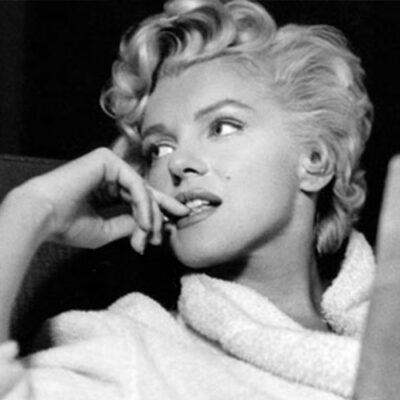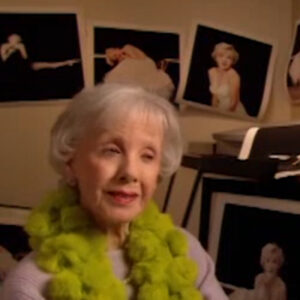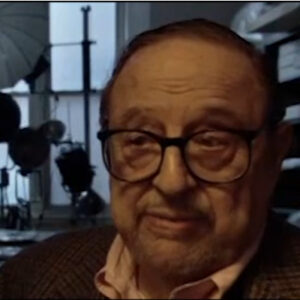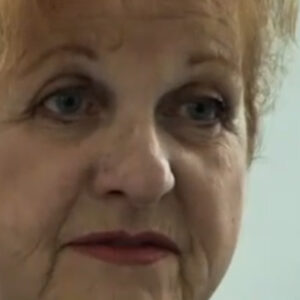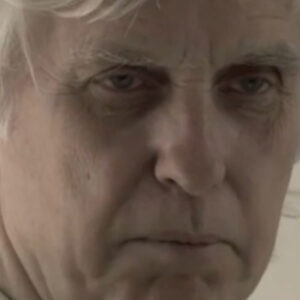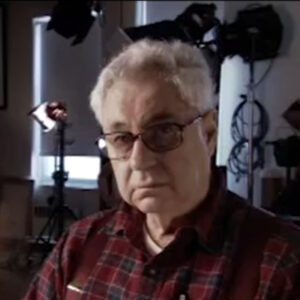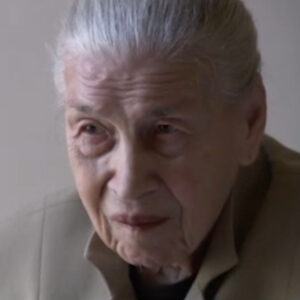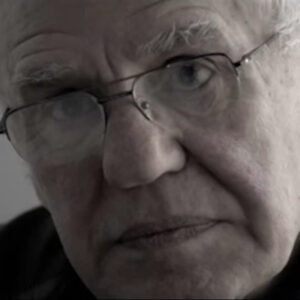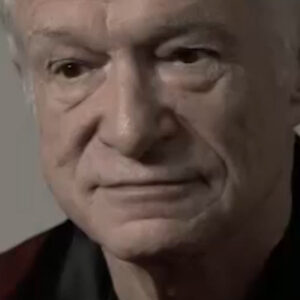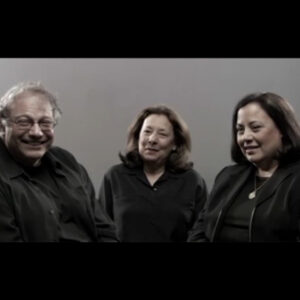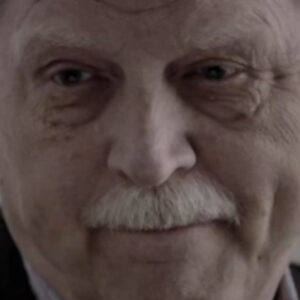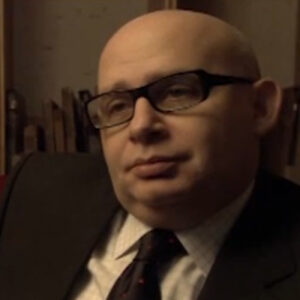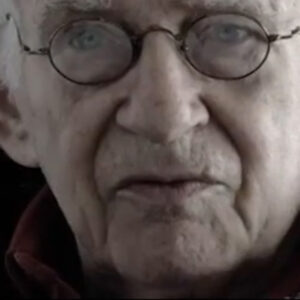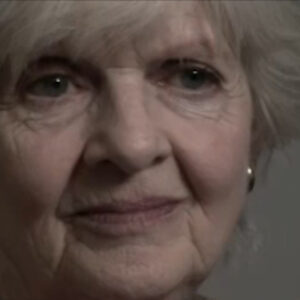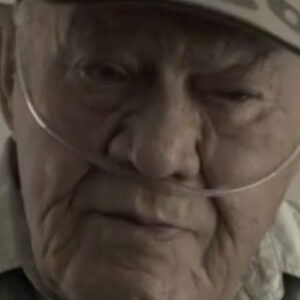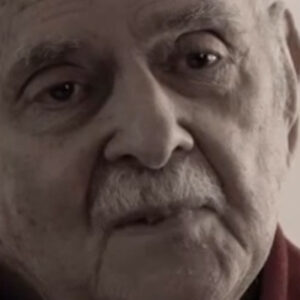Interviewer: Saying to you, tell me a little bit about your own feeling about the fact that this preponderance of this image all these years later?
Edward Pfizenmaier: Well, I’ve had a few interviews on this subject to Marilyn Monroe. And so, so beaten, of course, to start right off the bat. I’ve had a moniker I put on it, as I say, 50 years ago. The king photographs the queen. That’s what it’s all about. And somehow, five decades later, it seems to be still that’s what it’s what’s going on between the two of them to begin with initially. What we started with the shoot, Cecil and I, we had no idea what was going on, what we were getting into. We’ve heard all of the rumors and they were rumors as far as I’m concerned, because the whole thing worked out so beautifully for a start with. She arrived at Lily Innuendo. I had mentioned before that she wasn’t in the door. You know, she had a bag and a couple of dresses in it, a puffy white thing and a simple black dress. Marilyn over the shoulder, this kind of thing came in the door and the first thing she did was discarded the shoes, her shoes, which I couldn’t believe. So I immediately accessible and I looked at each other with big eyeballs. And we could tell for some reason this was going to be a good day. I mean, I kind of adore somebody that throws shoes off and gets right. In other words, she wanted to work. No time for coffee, no discussion. One word, the hair. She wasn’t there five minutes and she wanted to work. So this is a very good omen. So my thought and we weren’t wrong because it was a successful shoot. It really was. I mean, there’s so many pictures involved with it, you know, but.
Interviewer: So tell me a little bit about him. Tell me a little about him, how he normally worked and what his temperament was like. Because you say the feeling he was very knowing that very well.
Edward Pfizenmaier: Cecil is the entrepreneur of everything everybody thinks and not everybody. But a lot of people thought he was a photographer, not only photographer, an illustrator, a painter. You know, many shoots that we had with prominent people. Cecil would come and he rarely had a camera. Once in a while, he had a little of Aflex, you know, 50 year old Rolleiflex in his pocket because he knew that I would be there with all the lights and all the equipment and everything. And he was much more interested in painting, believing. He did watercolors. And a lot of times we’re photographing. I was taking pictures and he was doing a watercolor. This kind of thing of the subject matter and beautiful things. I did illustration pieces of her.
Interviewer: Did he do it? Did he do a watercolor, Marilyn?
Edward Pfizenmaier: No, he didn’t. No, no, no. I don’t know why. It was always. I don’t know why he didn’t bring his things to that point. Quite frankly, we didn’t know what to expect one way or the other. That’s why it was a pleasant, pleasant surprise when we really got going. And she insisted on starting work right away. Do you want to call it work? It was couldn’t have been more pleasant. Believe me.
Interviewer: Now backup to you at that point. You’re a very young guy at that point. And here is the is the movie. The movie queen walks in. And how I mean, that was that for you?
Edward Pfizenmaier: Well, we’re talking 50 years ago, and I think we were you know, I was in fashion photography, you know. That was basically my training and what I wanted to do and do eventually get into. And it was the Twiggy or the whole thing. And we were, you know, not necessarily buxom women or property. Gurley Brown at Cosmopolitan was big. She was way ahead of everybody with the bosoms and this kind of thing. You know, she was pushing that. But my training is sort of blogger for in the beginning, you know, I was always sort of the twiggy. Look, I keep talking about, you know, the stakes, you know, and course, that’s what fashion photography is all about. You know, the thinner a person is, it’s so much easier to photograph dresses and get the line that you want when you don’t have a large body underneath. And Marilyn had it. She really did. And that was. The Hollywood look, you know, but as far as photography goes, fashion photography, it really wasn’t even at that point, you know. So you asked me what I thought. I thought she was a very beautiful girl and wonderful West Coast look. You know, in Hollywood. But that’s about it. You know what?
Interviewer: She brought, you know, the first person to describe her as being willing to work. Many people that we’ve talked to have come with that sort of have made that statement George Zimbo talked about during the seven year itch stuff standing over the grave. And she worked and she was there and she was, you know, 100 percent, you know, willing. And I think this is an extraordinary quality in her. And I think her also desire for I think she’d love to be in front of a camera.
Edward Pfizenmaier: Oh, yes. No doubt about that. I mean, this is the kind of thing that made sense for myself that from the opening bell when she first came in, the shoes of immediately want to get into, you know what whatever we were up to. She was all flawed and never stopped a movie. Photograph within an hour or two. We had a long, warm session with never a break. But she loved it. She loved every minute. You know, you could see what was going on, you know. I know all the adjectives, her sexuality that everybody puts on labels right away, you know? And they were all true in a sense except difficult to work with. I could never understand that because we didn’t experience anything like that at all. I mean, she was just so beautiful all the time. And, you know, it really came off in the photographs. That’s what everybody says. They can see it. I never saw Cecil and Marlon both laughing, howling at each other because this was beaten. This is what brought it. He brought it out of her. I’m sure you know, but she was just in a very good mood. I don’t know what it was, but it was an incredible session. We had, you know.
Interviewer: Was there a difference between the time the camera was actually actually happening? Was there ever a moment in between? Or was she did she sort of maintain that aura throughout?
Edward Pfizenmaier: No, it went to pretty much the entire shoot. I mean, we didn’t stop for a moment. I mean. Well, that’s where Cecil works, too. He’s very quick. And we’re accustomed to anybody, you know, Sociably society, prominent people. You’re lucky if you get 20 minutes or half hour, that kind of thing. And I think Cecil and I both was we were taking all we could. This was like a blessing that you could take your time. And, of course, that it was in an ambassador hotel, which was Cecile’s suite, which he decorated himself when he came into the city from England or wherever he was, he stay in that suite. Otherwise, they’d be renting it out. And it was designed specifically in Sessoms mode, you know, for backgrounds. And we did most of our shoots in the suite in the ambassador. That’s where I was. And he had wonderful design wallpapers and fabrics and all kinds of fabrics, which I think all we had from now on, because that’s all we wrapping like George you san saying Angelo wrapping material around. Well, Cecil was wrapping all and all the time with different fabrics and that kind of thing. And she was pliable. Totally. We’re done now.
Interviewer: We’re just trying to stop the noise now. And that’s just the flexibility of her. The game.
Edward Pfizenmaier: Oh, no, no, no, no, Jean. Well, that famous quote that Cecil mentioned, I think in one of the interviews he had, that she just sort of romped in, jumped on the sofa. Well, that was one of the rare moments she put her shoes back on because Cecil said, I think we’re going to need your shoes. It’s sort of full length. Put the shoes on. And she romped and jumped on the sofa was a huge sofa that he had there. And she just was doing all kinds of cartwheels on that sofa, you know, from upside down and turning and twisting. And, of course, Marilyn’s famous look with the legs up in the air and everything else. And then that was an interesting series that we got on the couch alone.
Interviewer: She one of the things I’m struck by in the Couch series, speaking of her shoes, is the fact that it’s obvious she wore those shoes. Are his it’s. It’s obvious that those shoes that she wore. They’re not they’re not fashion. They the soles or, you know, the bottoms, the shoes are worn from the street. She’s not wearing perfect, you know, fashion shoes that have been brought in for a shoot that are clean on the bottom. And the fact that she essentially was her own stylist in this thing.
Edward Pfizenmaier: No, no. She had to. There were black shoes. And so she said she had a black dress in this duffle bag or whatever you call it. She had her black dress in a sort of a white, poofy evening dress. I don’t know the design I. I’m sure it was a designer dress. But I have no idea at this recollection what it was. And the black dress she had the black shoes for. That’s what it was. You know, I mean, it’s as simple as that.
Interviewer: But she was just her own person. There was no entourage. There was nobody with her. No makeup person, nothing.
Edward Pfizenmaier: And this is. Well, it’s a big difference from today. You know, I mean. Well, five decades ago, five, you know, 50, 50 years. So it’s quite a lot of hogwash has been made since then. I don’t know. Good or bad. But we had no makeup artists or stylists or anything like that. And it seemed to me that she seemed to like to work that way. That’s the impression she gave us. You know, I mean, doing conversations with her was beaten. She was talking in this that because he, quite frankly, was couldn’t understand. Oh, I’m sorry.
Interviewer: You are talking about the fact that she seemed to like working like this to very un encumbered with people, you know what?
Edward Pfizenmaier: Well, that’s the incredible part that we couldn’t understand, because my car she’s been. Well, you’ve seen the books.
Interviewer: OK.
Edward Pfizenmaier: That’s good. That’s part of the atmosphere.
Interviewer: All right. Go ahead. Start again. Well, where is everything? She you. You said that she seemed to be unlike being unencumbered in all of this. Any sense?
Edward Pfizenmaier: Well, I could have been. Maybe she’s used to photographing. I don’t know. There’s so many pictures of it and thousands and thousands and thousands of photographs and posters over. So it’s nothing new. She’s done everything she. I mean, he did it. I mean, there’s no two ways about it. But I have a feeling you had something to do with with Cecil, too. With Peyton. Although she didn’t come out and say it will show it in. Other than that, what she was producing for us that way. I mean, she did everything that he wanted to do from laying down on a bed and squats in a shade in him standing over and bare feet. He had bare feet. In that case, you know, shooting straight down on that kind of thing. And it did it just she seemed to adhere to everything that he mentioned. And he had lots of things in that suite of rooms that he could work with, you know, a way of backgrounds.
Interviewer: That she was for Harper’s Bazaar and one of the things that you were talking about that is is interesting and it’s interesting in the terms of sort of whole photographic legacy is what was a fashion shoot and what was a movie shoot. What was it, you know, what were the publicity shots or what were the seven year itch shots, for example, who was sort of what was the focus of the photographer? And in your case and then perhaps evidence case and I guess for it Stearnes case, most of the most of the photography was not really fashion magazine oriented. It’s interesting to hear you talk about sort of doing this in the point of view of a fashion photographer, because you don’t even think of her that way in a funny way.
Edward Pfizenmaier: Well, 50 years ago, we weren’t certainly thinking of Mylan’s proportions in the way of fashion photography. You know, I don’t mean to hoba emphasize that, but I was sort of weaned in those years above and I know how easy it is to do fashion when when no one. Yes. You’re working with absolutely nothing. You can pull and push and twist fabric and things when they’re when there’s nothing. You take a broom handle and may make a finger out of it, that kind of thing, you know. And in Hollywood, I mean, they will after the the sexuality and the publicity that they usually like to get on the West Coast. You know.
Interviewer: I guess I’m also talking about even her attitude, because it would strike me this was this was sort of pre certainly was pre the Brits in vogue sitting. So this was early in terms of her coming in and doing something that was really for a fashion. As if for a fashion venue as opposed to a. A star you, I guess.
Edward Pfizenmaier: Maybe, I don’t know. Maybe it’s just me, but for some reason I don’t think you could equate the two of them together. I mean, it’s just like black and white. It’s just Baumann’s look so overpowering. When she came in, you would think only one thing, you know. And that was not what she had on a I know who could care less what she had on that kind of thing.
Interviewer: And how did she pick the chip that she choose the gowns for that dress as. They were given. They were sent to her to wear for that.
Edward Pfizenmaier: What the gown.
Interviewer: Yeah. What are you wearing?
Edward Pfizenmaier: Oh, I have no voice telling us. I don’t know what the source was, where she had it. I’m sure the black dress is the little simple black dress. It might have even been her own, to tell you the truth. And that puffy thing, I we never got around. We did one or two pictures, but that didn’t really work out because it’s a little more voluptuous. It made her look more more that way, you know. But.
Interviewer: Beeton himself was very formally dressed during the whole thing.
Edward Pfizenmaier: Always. Well, in those days, I mean, we you know, everybody was a suit and tie three-piece suits and ties. So, I mean, it was the thing to do. I mean, Hoy’s that the settings, you know, and it was difficult for me because we were in those days, it was Tongson and lighting, you know, hot lights, no pupping strobes or anything like that. And that’s the other thing that had something to do with it. And I keep saying that Mouallem suddenly was purring under all our hot lights all the time. You know, it was a kind of a warm feeling that comes over you, you know. And we were in in suits all the time. So it got very difficult, you know, put paint noise, had bow ties and, you know, very, very, very elegant and formal all the time.
Interviewer: And also, you shot her at a very healthy time in her life. I think she was mentally happy at that point. She was not. I mean, you got her to a good moment.
Edward Pfizenmaier: She was the Arthur Miller thing around. You know, I think she was, what, thirty six.
Interviewer: Was just thirty six when she died.
Edward Pfizenmaier: I not. Thirty six.
Interviewer: Twenty eight. Thirty twenty five.
Edward Pfizenmaier: Thirty thirty. Something like that. Yeah. Because no as far as we could tell I could tell. I mean she, she. There were no no no problems at all whether you know. She certainly didn’t. To was but that’s a facade. It could be a facade. I don’t know. But she did do some beautiful things for us. I mean, and whatever Cecil wanted. That was the incredible.
Interviewer: We see herself in. That is back. I mean, did she. She also sort of, you know, encourage things herself or was it was it that she was really sort of just happy to be because she became, you know.
Edward Pfizenmaier: No, no, no. She was very inventive, so to speak. I mean, I don’t mean to be redundant again, but to mention that a couch series that did, you know. So so, you know, expect it and go and sit in the couch. And we started out with a very proper with the legs to the side and everything else. And then suddenly it all hell broke loose that she did a long thing. That’s when he mentioned the romping in the twisting and swallowing of the body around. She will finally wound up on the floor, half on the floor and half on the sofa. And she did some nice thing. She got she turned over, got on her stomach and put her legs up in the air and everything. You know.
Interviewer: That kind of secular thought about, though, is funny is is is sort of sad. There’s a little moment in that photograph that’s not so ropy as the rest of it. Which one? Right. The one where she’s on her stomach with her legs up in the back and she answered it by hand over it. It’s really a beautiful photograph.
Edward Pfizenmaier: Oh, no, no, no, no, no. At certain moments, she had it and any he had things to toy with, you know, like the daisy and the birds. And then it was a very quiet, subtle look that she had all the time with her, with the little props. You know, this kind of thing. But it it’s incredible. It really is. I mean.
Interviewer: And didn’t you feel quite wonderful? I mean, to be able to capture the pictures you got you’ve got this to the king and the queen at that point, aren’t you? Extraordinary people working together.
Edward Pfizenmaier: Well, I did that occasionally. You know what? In fact, most of the time, Sasso was very, very adamant with having me photograph a lot all the time, the two of them together. And I photographed the subject occasionally to especially when he was painting and, you know, doing a watercolor or something. He wanted photographs of the subject at the same time, which is what I. Do you know.
Interviewer: What, it’s an extraordinary document. From our point of view, they have sort of all sides of the camera there. You know, you have what his final photograph is that you are participating in that and his wells are creating. What are these setups with to really something? It gives it great. It’s sort of it’s sort of like watching a film get made. In some sense, because you get a bit of the inside of it, which is is wonderful.
Edward Pfizenmaier: Well, Cecil was very clever that way. I mean, there’s obviously many, many things he’s got involved in and publicity wise. He was he knew exactly what was going on. A lot of so-called Harrison photographers are beyonder or could be bought. But Cecil knew exactly what he was doing every minute. And I think you could apply that to now. I went to. He knew exactly what she was doing. I mean, he was an asset to her. And the value, which is incredible when you think of all the photographs that’s been taken over. And still, she had that feeling that these was something special. And she gave us that that indication.
Interviewer: Wasn’t one of the great photographs that he took from above with the flower is supposedly the one she loved the most of any that anyone ever took. You know the way you know that. So,.
Edward Pfizenmaier: Yeah, I mean, yeah, I had heard that I had met somebody mentioned that, but I couldn’t tell you the truth. You know, she liked the photograph so very much because we made oh, I don’t have any reprints. But for her, you know, she ordered many, many of the photographs. So obviously, she liked the design. I know whatever the what happened happened to the photographs. At this point, you know.
Interviewer: I think somewhere around we did a film a few years ago in film The Misfits, and one of the wives of one of the drivers that people had driven her and she’d given him inside one of those photographs. And, you know, it was great because they were truly around and I think people got them. There are people who are around her, you know.
Edward Pfizenmaier: That was one of the last films. Wasn’t it?
Interviewer: The Last.
Edward Pfizenmaier: Misfit a sad moment, but thank God that we’ve accomplished what we did when we did it, because it’s really a beautiful moment for them. We’ve gone through a lot. We beat them myself with photographing difficulties and problems, you know. But he’s a master at that kind of thing. I mean, you’ve seen the books that his photographs that he has, and he’s just about everybody’s world is photographed at one point the other.
Interviewer: But also, I would have to think for you, it was quite a thrill here at the early part of your own career to be in the presence of all of that.
Edward Pfizenmaier: Yeah, yeah. Well, I was twenty nine point twenty nine thirty years old when I was just beginning. You know, I was at the same time I was working with Horst from Vogue magazine all the time. And once I saw him in town immediately, I used to work with him. Shortly after that, I sort of had got my own studio. I think I was like in my early 30s when I I set up my studio. And I’ve been working ever since. In fashion, basically in cosmetic stuff that I was doing. You know.
Interviewer: Your photographs of this are are very nice as well. I mean, they’re not simply sort of snapping off. They’re they’re quite, quite involved. They’re quite emotional. They’re quite lovely. And I was actually thinking, in fact, you’ve got a couple of one of her from the back is just a terrific photograph.
Edward Pfizenmaier: Yeah. Well, then, yeah, I was so amused with that because she was sort of strutting herself out and Cecil was taking it all day. And that was early in the show till where she was fully clothed and had dressed as before we got into the wrapping of material and everything. But he was lying it as she approached him, you know, that kind of thing.
Interviewer: She was very shy about her body, wasn’t she?
Edward Pfizenmaier: Yeah. So there was no problem there whatsoever. I mean, which is to be expected from Marilyn. I mean, I’m sure we are were we weren’t the only ones that experience that. You know, how she was just it seemed like in another world when she was being that camera did something to her, you know? I mean, it’s it’s a it’s a pleasure to see something like that because we had something the negative negativity in photographing. So society. People, important people, you know, and so it’s kind of nice to have somebody like that and funny lands all the time.
Interviewer: Which came first. Did the puffy dress come first in the black dress? Just out of curiosity.
Edward Pfizenmaier: The puppy dress was first thing in it. I didn’t know we were painting it. We had a lot of problems with, you know, trying to make it look thin. You know, that was the whole problem. She just looked. I keep saying puffy because it was who’s very puffy. And now we had it pinned in all the way. In fact, one of the photographs, if you notice, it looks like it’s ruffled and pinned in the back, which it was with clothespins and everything. We were trying to make it thinner, make a thinner look out of that. And then we got into the black dress and then the latter part of the shoe was all materials wrapped in sheets and things in the bed. And everything was.
Interviewer: There was only one and there was only one day. There was only one, there was only one city.
Edward Pfizenmaier: One showed ya, ya know. We just had was I’m trying to recall just how long it lasted, which I don’t think we could believe it, but I think it was of about two hours. He was there, something like that. But photographing very quickly all the time. But that was the other great thing about Marilyn. But you know, as far as changing, I mean, well, let’s try something different. We’ll get to do this or that or wrap this around you and about it. No hesitation in between. She just do it right away. So we got into quite a bit. We shot a lot of film that day. Were mostly black and white because that was the era in those days, too. Because Cecil did he did color. I mean, but it wasn’t like black and white. That was the classic fine art photography in those days was mostly black and white and color was just coming online.
Interviewer: Another interesting thing I noticed when I have to work Celebes, when they had his stuff and you did the same thing, you printed me some of his contact sheets that he would move, that he did interesting things with the contact sheet, even print different versions sort of of the contact sheet suggests that.
Edward Pfizenmaier: He hated change that occasionally on it. We we heard a and that was my darkroom technician used to I had a dark room gonna use a door, all of developing and printing and everything on March now. And he’d want the context kind of thing. I don’t know whether I have the complete set I had at one point. I don’t know what’s whether what’s happened to them. But we did a lot of films and it was all a lot of it was a tutorial quarter. Yeah. Which is the role of Fox, basically. Know, I mean, I’m thirty five. We didn’t have an awful lot of 35 millimeter 50 years ago was the Brian and the house of that kind of thing and the Royal Flex which Cecil loved. I really did. That’s that one he kept in his pocket all the time that he used to bring out. Very rarely used that I always gave a camera. He always had a roll of wax that he could use that kind of thing.
Interviewer: Yeah, you have yours. That I think is so it’s quizes beautiful is that she’s just sitting front. That’s your picture. And it’s absolutely beautiful.
Edward Pfizenmaier: Yeah. What did the black dress with her or with the famous puffy dress. Well you will notice in the back there actually I’ve had that retouched. I think you just have a proof sheet that it’s all gathered, all the material is gathered in the back in the bed with clothespins and everything, because we were trying to slip the whole thing down, you know, but basically, I was just after getting jessalyn, which is not easy to do either, because all Aflex in those days, you were limited as far as lenses. Today, you got all kinds of lenses if you want to get it, six inches, 12 inches or two feet, three feet in a new subject, but a roll of flight crew, Sodus, normal lens. And you were a good distance away. So the challenge was to get. And the subject line in the same frame. And it was kind of difficult at times.
Interviewer: And you did.
Edward Pfizenmaier: Because he’s a pretty good distance a couple of five, six feet away from her all the time, you know, and it’s typical in when you think of the limitations that we had with the so called world of Flex as opposed to today. It’s incredible that he got what he did.
Interviewer: You also succeeded.

